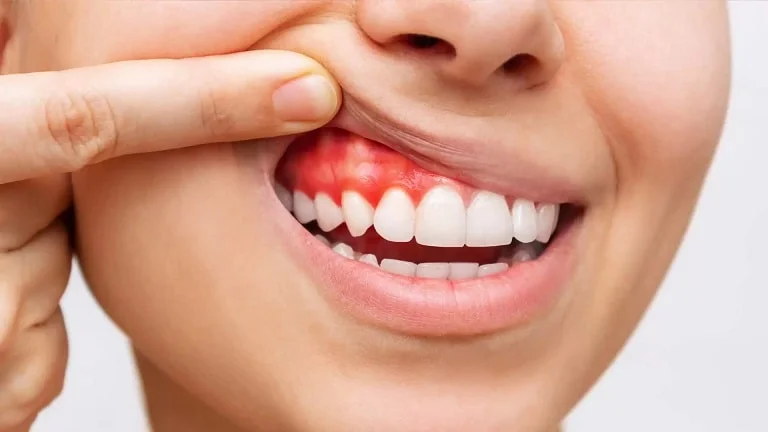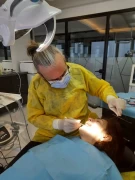
Gum Diseases: A Silent and Progressive Threat
- Gum Diseases: A Silent and Progressive Threat
- What Are Gum Diseases?
- Classification of Gum Diseases
- Symptoms of Gum Diseases
- Causes of Gum Diseases
- How Is It Diagnosed?
- Treatment Options for Gum Diseases
- At-Home Preventive Recommendations
- The Link Between Gum Diseases and Overall Health
- Conclusion: Healthy Gums Are the Key to a Healthy Life
As a practicing dentist, the majority of my patients seek treatment for toothaches, cavities, or aesthetic concerns. However, what many of them do not realize is that the real threat to oral health often lies in gum diseases. These conditions typically progress silently; they do not cause pain in the early stages, but if not diagnosed and treated in time, they can lead to serious consequences, including tooth loss. In this article, I aim to raise awareness among my patients and the broader community by sharing everything you need to know about gum diseases from a professional perspective.
What Are Gum Diseases?
Gum diseases are inflammatory conditions that affect not only the gums (gingiva) but also the supporting structures of the teeth, including the bone tissue, periodontal ligament, and cementum. These diseases may begin with mild redness in the gums, but if left untreated, they can advance to the point of damaging the bone that supports the teeth, eventually resulting in tooth loss.
Classification of Gum Diseases
We generally classify gum diseases into two main categories:
- Gingivitis (Gum Inflammation):
Gingivitis is the earliest and mildest form of gum disease. It is characterized by redness, swelling of the gums, and bleeding during brushing. At this stage, there is no bone loss. With proper brushing, flossing, and professional cleaning, full recovery is possible. - Periodontitis (Advanced Gum Disease):
If gingivitis is left untreated, the inflammation progresses below the gum line and reaches the bone tissue surrounding the teeth. At this stage, "periodontal pockets" form between the gums and the teeth. Over time, these pockets deepen, and bone loss begins. Periodontitis is irreversible, but its progression can be halted.
Symptoms of Gum Diseases
I always tell my patients: “Just because there’s no pain doesn’t mean there’s no problem.” Gum diseases are typically painless in the early stages. However, the following symptoms should never be ignored:
- Bleeding gums while brushing or spontaneously
- Swelling, redness, or tenderness in the gums
- Bad breath (halitosis)
- Gum recession, making teeth appear longer
- Gaps forming between teeth
- Loose or shifting teeth
- Sensitivity or pressure while biting
If you experience even one of these symptoms, it is important to consult a dentist.

Causes of Gum Diseases
The primary cause of gum disease is microbial dental plaque – a bacterial film that accumulates on the tooth surface. However, many additional factors can accelerate or exacerbate the condition, including:
- Inadequate oral hygiene
- Smoking and use of tobacco products
- Diabetes (especially if uncontrolled)
- Stress
- Genetic predisposition
- Hormonal changes (pregnancy, puberty, menopause)
- Certain medications (antidepressants, antihypertensives, antiepileptics)
- Teeth grinding/clenching habits
- Poor or faulty restorations and ill-fitting prosthetics
How Is It Diagnosed?
Clinical examination is the most critical step in diagnosing gum diseases. I always measure the depth of the gum pockets in each patient using a periodontal probe. In addition, I assess for tartar buildup, bleeding, gum recession, plaque accumulation, and tooth mobility.
When necessary, radiographic imaging (panoramic or periapical X-rays) is used to detect the level of bone loss. This helps determine the stage of the disease and allows us to develop an appropriate treatment plan.
Treatment Options for Gum Diseases
Treatment is planned based on the stage of the disease. The primary goal is to control the infection and stop the progression.
- Professional Dental Cleaning (Scaling):
The most effective and sufficient treatment during the gingivitis stage. Tartar and plaque are removed using ultrasonic devices. - Root Surface Debridement (Curettage):
For patients with periodontitis, infected tissues inside the pockets are cleaned, and the root surfaces are smoothed. This is done under local anesthesia. - Advanced Surgical Procedures:
In cases with very deep pockets, flap surgeries, bone graft applications, or regenerative treatments may be necessary. - Supportive Therapy:
Following treatment, regular check-ups, effective home care education, smoking cessation support, and other preventive measures should be implemented.
At-Home Preventive Recommendations
- Brush teeth at least twice a day using the correct technique
- Use dental floss or interdental brushes daily
- Use mouthwash if recommended by your dentist
- Visit your dentist every six months for check-ups
- Avoid sugary and acidic foods
- Refrain from smoking or using tobacco products
- Consult your dentist if you experience dry mouth
The Link Between Gum Diseases and Overall Health
Recent scientific studies have shown that gum diseases not only affect oral health but also have an impact on overall systemic health. They are particularly linked to conditions such as heart disease, diabetes, pregnancy complications, and respiratory infections. Therefore, maintaining periodontal health is crucial not just for our teeth but for our holistic well-being.
Conclusion: Healthy Gums Are the Key to a Healthy Life
Gum diseases often follow a silent, insidious, but progressive course. As a dentist, my greatest hope is that my patients recognize this issue in its early stages and seek treatment promptly. With early diagnosis and proper treatment, it is possible to protect both dental and general health. Consider your oral health as a whole, and give your gums as much attention as you do your teeth.
Remember, pink and non-bleeding gums are the most basic indicators of health.
Wishing you all a healthy and confident smile...

Dentist Mümtaz H. Uğur





